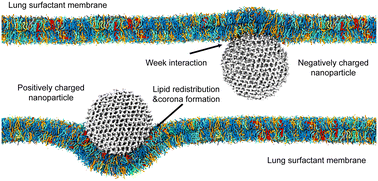Lipidomic analysis probes lipid coronas on hydrophilic nanoparticles from natural lung surfactant†
Abstract
The large respiratory surface and high permeability make the lung promising in drug delivery of inhaled nanoparticles (NPs) as a portal and susceptible to nanosized airborne pollutions. Inhaled NPs first interact with the lung surfactant (LS) after depositing in the lung, where NPs tend to adsorb the LS molecules to form a biomolecular corona on their surface. Despite the extensive studies of protein coronas from blood plasma or serum, lipid coronas that are constituted by LS molecules are rarely investigated. Herein, we combine high-performance liquid chromatography-mass spectrometry and molecular dynamics simulation to unravel how a lipid corona is formed on hydrophilic NPs from a natural LS. Experiments demonstrate that positive surface charge, long incubation time, and external sonication can promote the formation of a complete lipid corona with compositions different from the bulk LS. Complementary to the experiments, molecular simulations indicate that the surface charge of NPs plays a vital role in the interactions of NPs with both zwitterionic and anionic lipids, which determines the wrap of the LS bilayer on the NP. In addition, the difference in the lipid composition between the corona and the bulk LS is caused by the affinity of NPs with lipids and the intrinsic structure of lipids. These results suggest that it is possible to control the formation and composition of lipid coronas on hydrophilic NPs by tuning the surface coating of NPs and incubation conditions.

- This article is part of the themed collections: Nano-bio interactions and Environmental Science: Nano Recent HOT Articles


 Please wait while we load your content...
Please wait while we load your content...